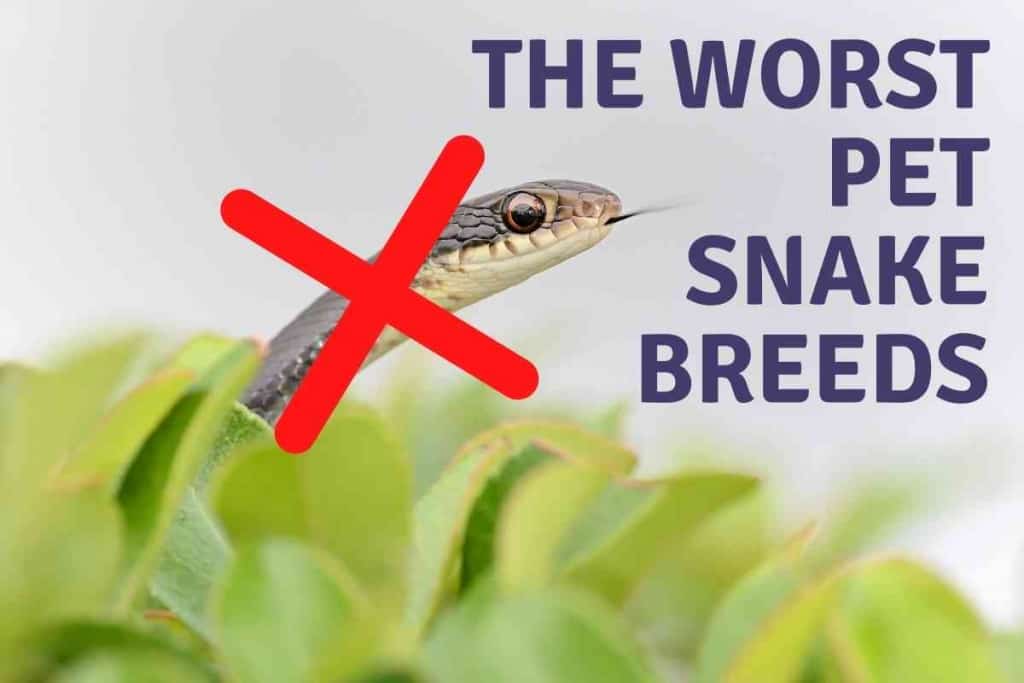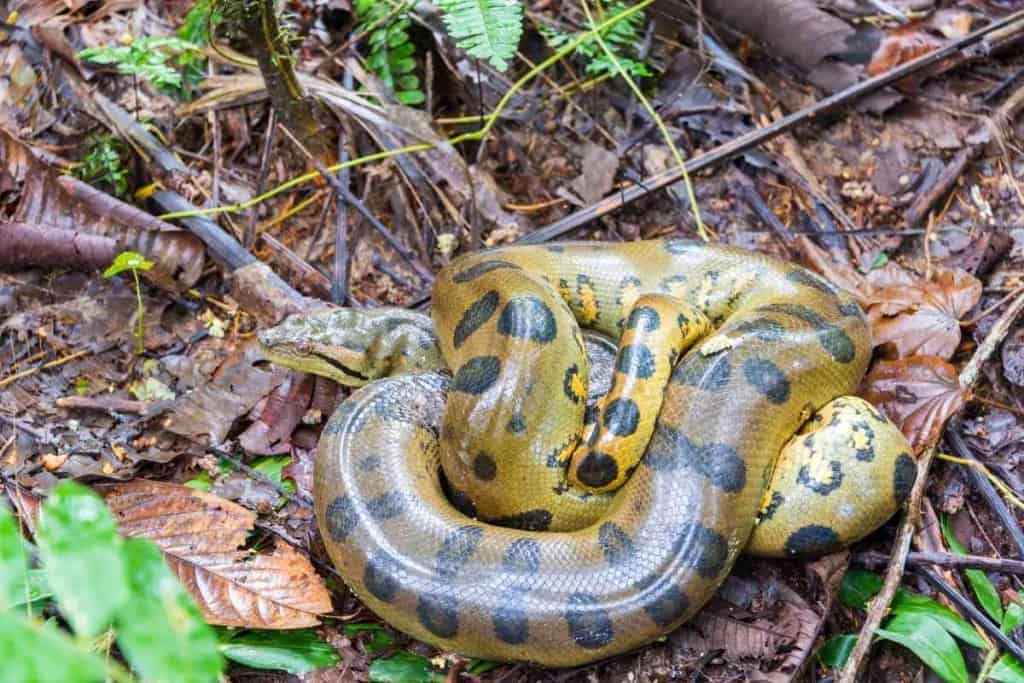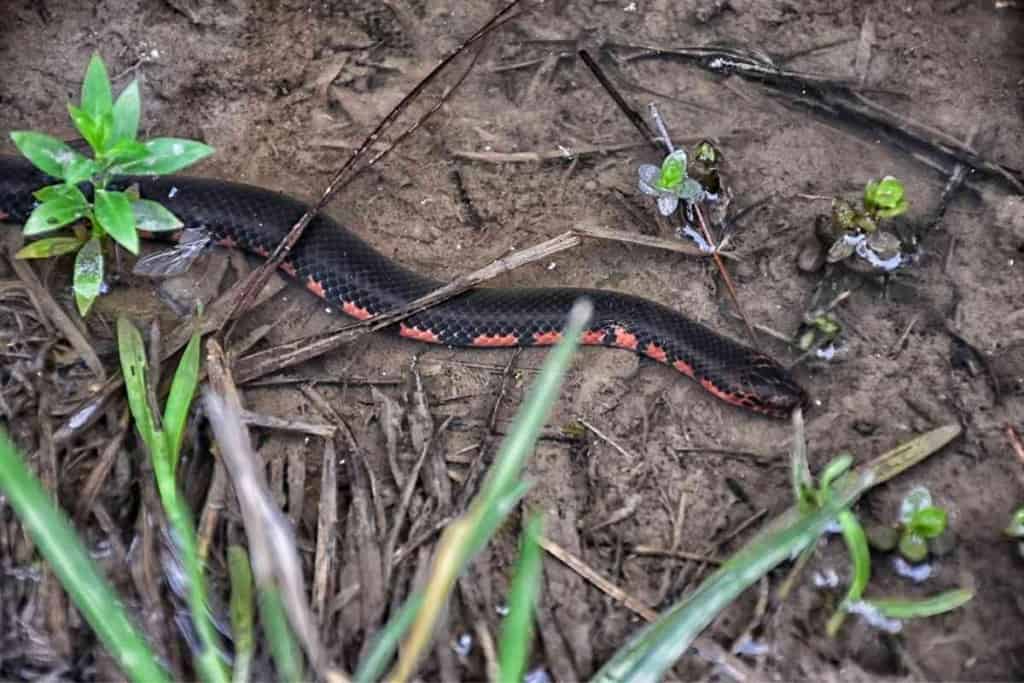10 Worst Pet Snakes And Why You Should Avoid Them!
Choosing the suitable snake species is the most challenging task that beginners undertake while looking for a pet snake.
Making the right choice for petting snakes depends on several factors. Nobody would like to end up petting dangerous snakes. It would always be wiser to conduct extensive research and learn more about any snake before keeping it under captive care, especially if you are considering a large snake breed or a venomous snake. Also, seek advice from professionals and experienced snake owners.

What are the worst pet snakes to own?
The worst pet snakes include viper Boas, African rock python, Green Anaconda, flying snakes, black racers, and Wild-caught Ball Pythons. They are the worst pet snakes because they pose many maintenance difficulties. These snakes are unfriendly and very aggressive, and they tend to bite humans.
Some snakes from the wild find it hard to adjust to their captive habitats. These snakes will not bond with humans like friendly snake breeds, which are submissive and live well in their enclosures.
On the other hand, the worst pet snakes behave irritably and usually are unwilling to eat. These kinds of snakes will not be easy to keep comfortable at home.
Snake species that have been caught in the wild take longer or even never end up having a friendly relationship with their owners.
These snakes have an attitude that you can neither predict, making them unsuitable for pets.
10 Worst Pet Snakes
Many snakes are unfavorable for keeping as pets. The main reason why a snake falls under the worst pet snake category is due to the high risk of harming the owner. Also, some snakes require unique conditions that it’s challenging to keep them in captivity.
Below are ten snake species that make the worst pets.
1. African Rock Python

African Rock Pythons are giant snakes that grow up to 32 feet long. These snakes are aggressive and are not suitable as pets as they can be dangerous, especially in households with children.
These snakes require a lot of food. As these snakes grow more prominent, so does their demand for food.
Their growth rate depends on the feeding regimen. Another problem with petting African Rock pythons is that they are prone to infectious diseases and parasites.
It’s always good to purchase these snakes from a reputable breeder rather than getting them in the wild. External parasites can attack captive-bred snakes, and this is one major problem when keeping African Rock Pythons as pets.
African Rock Pythons are also susceptible to respiratory disorders like pneumonia. In most cases, when these snakes get an infectious disease, they don’t heal quickly.
The African Rock Pythons have a reputation for being the worst pets. They have an irritable temperament; hence they can lash out and bite whenever they feel threatened. Mostly, these snakes are wild-caught. That’s why they are amongst the worst pet snakes.
2. Reticulated Python
The Reticulated Python is another massive snake species that, just like the African Rock Python, can grow up to 20 feet or more.
The Reticulated Pythons require a large enough enclosure for their enormous growth, especially if they are wild-caught.
These snakes are not used to being handled by humans and may startle easily. Some of the reasons why Reticulated Pythons are unwanted pets are:
- These pythons can grow so huge that they need an expensive setup to hold them.
- Reticulated Pythons are not as affectionate as other pet snakes.
- These pythons prefer to feed on live prey.
- Reticulated Pythons are apex predators, and they may end up killing their owners.
- Reticulated pythons are not friendly pets. They can coil around a human being and strangle them to death.
Like other unsuitable pets, Reticulated Pythons suffer from common health problems like respiratory issues, retained shed, impaction, parasites, and wounds inflicted by live prey. The nature of reticulated pythons affects their suitability as pets.
3. Boa Constrictors
Boa constrictors are considered a poor choice of pets. Adult Boa Constrictors can grow up to 13 feet long. Although Boa Constrictors are not intentionally aggressive, they can injure and kill humans.
These snake species will not reward you for offering them food and comfort. Boa constrictors kill their prey by wrapping their body through them and then constricting their muscles.
Mostly, these snakes constrict during feeding time.
It is always wise not to approach Boa Constrictors during feeding as they may easily mistake you for prey. These snakes constrict whenever they feel threatened or excited by something in the environment.
Children are at risk of handling Boa Constrictors because these snakes can easily overpower them. These constrictors are dangerous and unsuitable pets as they kill their owners or close people.
Boas can feed on anything they catch. They have jaws that can stretch wide enough to swallow large prey as a whole. Boa constrictors can feed on:
- Birds
- Lizards
- Rodents
- Squirrels
- Bats
In captivity, Boa constrictors typically feed on rodents.
4. Green Anaconda

Like many other large constrictors, the Green Anaconda is among the worst pet snakes. These snakes require advanced husbandry techniques and proper veterinary care. Green Anacondas grow up to 14 feet long and weigh 485 pounds.
Anacondas take at least two to three days to digest food because they feed on larger prey. Overfeeding Green Anacondas, however, can lead to health issues.
Stress also affects these constrictors once they have been kept captive and fail to eat.
Taking care of Green Anacondas is quite tricky as they incredibly have a higher probability of carrying parasites and foreign bacteria. These snakes usually have a hard time adjusting under captive care.
Some of the reasons why Green Anacondas are among the worst pet snakes are:
- Green Anacondas are the heaviest among all snakes, as one can weigh up to 485 pounds. This means that they require a lot of food while in captivity.
- These snakes spend a lot of time in the water. Their water tank requires regular cleaning, which is quite a lot of work.
- The Green Anacondas are short-tempered and can attack any time
- These snakes are always at risk of parasite attacks and disposition.
Although Green Anacondas can do well under captive care, they are ideally not among the best snakes to keep as pets.
5. Burmese Python
The Burmese Python grows up to 20 feet long and weighs 200 pounds. Due to their vast size, these snakes are hard to take as pets because their maintenance care is quite tricky.
The Burmese Python reproduces very quickly while captive; hence can end up invasive breeding populations.
Keeping a Burmese Python is expensive, and one handling mistake can make the snakes kill you. Burmese Pythons are the worst pet snakes as they require a lot of food, water, a lot of cleaning, and medical attention.
The Burmese Pythons predominantly suffer from the inclusion body disease. They are also susceptible to respiratory infections, mouth rot, and stomatitis.
While looking forward to keeping a Burmese Python as a pet, it’s good to consider whether you have the patience, time, and space to care for it as it’s among the worst pet snakes.
6. Flying Snakes

Flying snakes are not receptive to affection. They are wary animals who do not like handling as it is stressful. These snake species feed on lizards, smaller snakes, frogs, mice, and rats.
Flying snakes are diurnal; hence, keeping them as pets is not good.
The other reason Flying snakes are dangerous to keep as pets is that they are venomous. They inject venom through the fangs at the back of their mouth. Once they feel threatened, these snakes bite.
The bites from these snake species cause pain and swelling.
Even though Flying Snakes are not giant snakes, the captive environment is unsuitable. They like living in the open, where they can look for prey from tree to tree. Flying snakes do not require much maintenance care, but they are not suitable to keep as pets.
7. Wild-Caught Ball Pythons
Wild-caught Ball Pythons are among the worst snake pets to consider as starters. These snakes require much care and attention, and they are not affectionate.
Wild-caught Ball Pythons are complex animals, and they display behaviors expected in the wild.
Without the proper standards for captivity, Wild-caught Ball Pythons can experience stress, malnutrition, diseases, and even premature death. While kept in captivity, these snakes cannot fully meet their biological needs and exhibit their natural behaviors.
It is tough for wild-caught Ball Pythons to undergo genetic alteration. Therefore, these snake species cannot have their wild behavioral traits. Some of these natural behaviors include:
- Forage
- Mating
- Avoiding predators.
Keeping these snakes under captive care limits the expression of their full range of natural behaviors.
Another major problem with keeping Wild-caught Ball Pythons as pets is that it is often difficult to feed them. Most of the time, these snakes have an ill temper, and controlling them becomes a difficult task.
Lastly, Wild-caught Ball Pythons tend to have health problems. They carry parasites and suffer from zoonotic diseases that they can transfer to humans.
Wild-Caught Ball Pythons contract diseases like salmonella and respiratory disorders.
8. Black Racers
Most of the Black Racers offered for sale are primarily caught in the wild. This makes them not suitable for captivity. Black Racers are wandering serpents. Therefore, they require a lot of space to roam around. These snakes require about 14 hectares of space where they can wander.
Although Black Racers can survive in different habitat setups, they prefer open fields where they have the freedom to hunt down their prey. These snakes’ favorite habitats are the open woodlands, fields, and grassland. This tells you why it’s not a good idea to keep them under captive care.
These snakes are stunning, but they aren’t suitable for captivity. Black Racers are among the worst pet snakes because they are defensive snakes. They do not calm down easily no matter how long you keep them under captivity.
Black Racers are not particularly docile snakes, and they never become accustomed to handling.
Black Racers do not thrive in small habitats. If you have to keep them as pets, you will have to give them a large space as they are accustomed to the freedom of traveling for long distances freely.
Unlike some other snakes, Black Racers do not make good pets.
9. Mud Snakes

Mud snakes mostly inhabit muddy areas where they can afford to bury themselves underneath the wet soil. These snakes prefer living in the following areas:
- Marshes
- Under the ground debris
- Areas with dense vegetation
- In the stream edges
As much as Mud Snakes are not endangered species, they are among the worst pet snakes. These snakes’ diet mostly consists of amphibians.
People believe that Mud Snakes can bite and chase humans. However, these snakes do not bite unless provoked, and they are not considered dangerous.
The major reason why Mud Snakes are among the worst pet snakes is that they are extremely picky eaters. Once you keep these snakes under captive care, they can refuse to eat anything. This is a harmful behavior that inevitably leads to their death.
10. Viper Boas
Wild-caught Viper Boas come with many problems, hence making them unsuitable pets. In most cases, many Viper Boas do not survive captivity as they die. It is tough to acclimatize to these snake species.
Without better knowledge of husbandry and captive-bred snakes, it can be challenging to keep Viper Boas alive under captive care.
Viper Boas require a lot of care while captive, such as providing the correct temperature, diet, medical attention, and cleaning their enclosures.
Viper Boas require high humidity, and it is hard to keep these snakes. Viper Boas are very aggressive, especially when new to captivity. They undergo stress, giving them a bad temper and exposing them to health problems.
It takes time for the Viper Boas to acclimatize to the captive environment. These snakes get defensive whenever you try to handle them. Their immediate reaction to handling is biting.
As with other snake species, Viper Boas are susceptible to various illnesses.
Some of the Viper Boas’ common health issues are
- Mouth and Scale Rot
- Snake Mites
- Respiratory Infection
Viper Boas require good housekeeping, quarantine, and a good rodent supply. These snakes are among the worst pet snakes because they are temperamental and aggressive.
